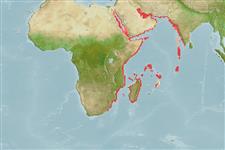>
Ovalentaria/misc (Various families in series Ovalentaria) >
Opistognathidae (Jawfishes)
Etymology: Opistognathus: Greek, opisthe = behind + Greek, gnathos = jaw (Ref. 45335); to the very elongate upper jaw of the type species of the genus, Opistognathus nigromarginatus (Ref. 128653); muscatensis: Named for the type locality Muscat, Oman..
More on author: Boulenger.
Environment: milieu / climate zone / depth range / distribution range
Ecología
marino asociado a arrecife; rango de profundidad 15 - 50 m (Ref. 9710), usually 30 - 50 m (Ref. 27115). Tropical; 18°C - 24°C (Ref. 27115)
Western Indian Ocean: Durban, South Africa to the Persian Gulf, including Mahé Island, Seychelles (Ref. 5468). Not in Red Sea (Ref. 84159).
Tamaño / Peso / Age
Maturity: Lm ? range ? - ? cm
Max length : 45.0 cm TL macho / no sexado; (Ref. 9710); common length : 30.0 cm TL macho / no sexado; (Ref. 5450)
Espinas dorsales (total): 11; Radios blandos dorsales (total): 15; Espinas anales 3; Radios blandos anales: 15. This species is distinguished by the following characters: short supramaxilla and mostly rigid maxilla with only a slight flexible lamina posteriorly; an ocellated spot on the dorsal fin, between third or fourth and eighth spines followed by two large, irregular, dark blotches that extend onto body, and a blackish streak on cheek bordering upper edge of maxilla; outermost segmented pelvic-fin ray is tightly bound to adjacent ray, with interradial membrane not incised distally or only slightly at tip (vs. interradial membrane deeply incised in all other Indo-Pacific Opistognathus (Ref. 81517).
Black spot between 3rd and 8th dorsal fin spines, fin also with 2 large blotches that extend onto body; body and dorsal fin with spots and blotches bordered with pale blue (Ref. 5468).
This species is occasionally encountered in the fish market and its flesh is reported to be relatively good. It is taken incidentally in bottom trawls and by hook and line at 30-50 m (Ref. 81517).
Life cycle and mating behavior
Madurez | Reproducción | Puesta | Huevos | Fecundidad | Larva
Smith-Vaniz, W.F., 1986. Opisthognathidae. p. 726-727. In M.M. Smith and P.C. Heemstra (eds.) Smiths' sea fishes. Springer-Verlag, Berlin. (Ref. 5468)
IUCN Red List Status (Ref. 130435)
Threat to humans
Harmless
Human uses
Acuario: Comercial
Más información
Nombres comunesSinónimosMetabolismoDespredadoresEcotoxicologíaReproducciónMadurezPuestaAgregación para la puestaFecundidadHuevosEgg development
ReferenciasAcuiculturaPerfil de acuiculturaRazasGenéticaElectrophoresesheritabilidadEnfermedadesProcesamientoNutrientsMass conversion
ColaboradoresImágenesStamps, Coins Misc.SonidosCiguateraVelocidadTipo de nataciónSuperficie branquialOtolitosCerebrosVisión
Herramientas
Special reports
Download XML
Fuentes de Internet
Estimates based on models
Preferred temperature (Ref.
123201): 22.4 - 28.3, mean 26 °C (based on 73 cells).
Phylogenetic diversity index (Ref.
82804): PD
50 = 0.5000 [Uniqueness, from 0.5 = low to 2.0 = high].
Bayesian length-weight: a=0.00389 (0.00180 - 0.00842), b=3.12 (2.94 - 3.30), in cm total length, based on all LWR estimates for this body shape (Ref.
93245).
Nivel trófico (Ref.
69278): 3.8 ±0.6 se; based on size and trophs of closest relatives
Fishing Vulnerability (Ref.
59153): Low to moderate vulnerability (35 of 100).
